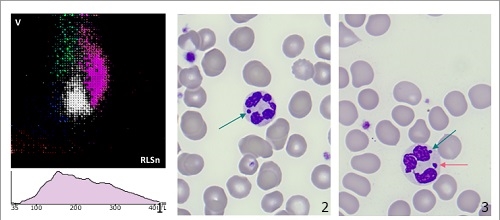Unexpected Inclusions – Howell-Jolly body-like Inclusions in Neutrophils Mimicking Basophils in Scatter Plot
Image Description
A 34-year-old woman with chronic kidney disease underwent a kidney transplant, currently on immunosuppressive therapy, presented to the emergency department with left flank abdominal pain and fever with 3 days of evolution.
On admission, blood tests showed hemoglobin 10.2 g/dL, leucocytes 8.100x109/L, platelets 203x109/L; the scatter plot showed a cluster in the basophil region (Fig. 1), with a corresponding total basophil count of 1.88x109/L (23.3%). The complete blood count was repeated using the same equipment, Beckman Coulter DxH 900 Hematology Analyzer, revealing similar results. The peripheral blood smear showed neutrophils with Howell-Jolly body-like inclusions – HJBL - (1.215x109/L, 15%) and also Barr Bodies (0.486x109/L, 6%) (Fig. 2 and 3), but no basophils.
HJBL are detached pycnotic nuclear fragments in the cytoplasm of neutrophils and occur as a consequence of dysplastic granulopoiesis, resembling the Howell–Jolly bodies present in erythrocytes [1,2,3].
HJBL are linked to immunosuppression, viral infections and chemotherapy [1,3], with studies showing a correlation to myelodysplastic syndrome [2].
The Barr body, typically seen in females, appears as a drumstick-shaped appendage of a nuclear lobe [1].
No published data was found about neutrophils with inclusions being counted as basophils by fully automated blood cell analyzers. Once Beckman Coulter DxH 900 separates and counts the leukocytes according with their volume and cellular complexity using Volume, Conductivity and Scatter (VCS) technology, we believe that HJBL, being such densely basophilic, alter neutrophil’s complexity, so they are identified as basophils by the equipment, showing a cell cluster on the basophilic region on a scatter plot.
References
Omman R, Kwong C, Shepherd D, Molnar JA, Velankar MM, Mirza KM. Revisiting Howell-Jolly Body-Like Cytoplasmic Inclusions in Neutrophils: A Report of Two Cases and Confirmation of Nuclear Origin. Journal of Hematology [Internet]. 2017 [cited 2024 Aug 7];6(4):101. Available from: https://doi.org/10.14740/jh334w
Tong YT, Nguyen ND, Wahed A. Howell-Jolly Body–Like Inclusions in Neutrophils of Patients With Myelodysplastic Syndrome: A Novel Correlation. Archives of Pathology & Laboratory Medicine [Internet]. 2019 Jan 1 [cited 2024 Aug 7];143(1):112–4. Available from: https://dx.doi.org/10.5858/arpa.2017-0328-OA
Barros Pinto MP, Marques G, Cristino JM. Not only but also: macropolycytes in sepsis by Serratia marcescens. Hematology, Transfusion and Cell Therapy [Internet]. 2022 Oct 1 [cited 2024 Aug 7]; 44(4):614–5. Available from: DOI: 10.1016/j.htct.2021.06.014


